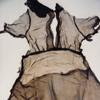カナダ・バンクーバー UBC(ブリティッシュコロンビア大学)人類学博物館で、石内都写真展「ひろしま」が10月13日にオープニングします。これは、「映画 ANPO」が昨年バンクーバー国際映画祭で上映され、監督リンダ・ホ―グランドさんを迎えた会を持ったことなどがきっかけになって実現した写真展です。バンクーバー九条の会の発起人の一人でもあるコピソン珠子さんに大きな役割を果たしていただきました。リンダさんを迎えた会が昨年の10月13日であったことを思うと、今年の同じ日、2011日10月13日にこの写真展のオープニングがあると思うと感慨深いです。@PeacePhilosophy
日本語による石内都さん作品の紹介はこちらをご覧ください。
以下、UBC人類学博物館より Museum of Anthropology, the University of British Columbia
ひろしま hiroshima
by Ishiuchi Miyako
Opening reception: Thursday, October 13, 2011, 7:00 pm (everyone welcome).
Exhibition dates: Friday, October 14, 2011 through Sunday, February 12, 2012
This powerful exhibition features 48 photographs by Ishiuchi Miyako of clothing and accessories left behind by victims of the 1945 atomic bomb at Hiroshima. Unlike the black-and-white images most often associated with Hiroshima, showing devastated landscapes emptied of humanity, Ishiuchi’s colour photographs represent her own deeply personal, intimate encounters with everyday objects that, unlike the people to whom they once belonged, continue to exist in the present. Testaments to a profound trauma, they also illuminate the beauty, diversity, and complexity of individual lives in ways immediately accessible to contemporary audiences.
Ishiuchi writes: From the 19,000 items made available to me [at the Hiroshima Peace Memorial Museum], I chose things that at one time had touched skin and bodies, and photographed them…. A flower-patterned dress colourfully dyed. A puff of gathered, shiny skirt woven of silk thread. Cool-looking, thin, georgette materials that once shed the summer heat. Used kimonos transformed into blouses and cut to make air-raid hoods…. These objects, exposed to the heat and radioactive rays of a fire ball that suddenly appeared one summer morning, and relinquished by the victims of the atomic bombing, have been on earth as long as I have. When I came to realize the coincidence, I caught my breath at their vivid hues and distinct textures, their flaws and complicated detail. These are too deeply linked to daily lives to regard as ‘historical materials.’
Born in 1947 in Gunma Prefecture, Japan, Ishiuchi began her artistic career in the late 1970s and is now one of that country’s leading contemporary photographers. Her work focuses on the representation of the human body, and her subjects are often directly related to her personal history: “1-9-4-7” documented the hands and feet of women born the same year as she; and “Mother’s 2000-2005, Traces of the Future,” explored the intimate elements of her mother’s presence and memory. Since the 1980s, she has been photographing scar tissue: indexical renderings of physical wounding and life narratives on the body. For her, photography is a medium of remembrance and monumentalizing, and an active agent in memory making. She exhibits internationally and her work is held in public collections in Canada and around the world.
Through the exhibition and a wide range of public programming, MOA will provide a forum for examining issues of war, trauma, and remembrance, and the role objects play in our collective memory.
A catalogue featuring images from the exhibit and essays in English and Japanese will be available for purchase in the MOA Shop. Also available will be a monograph edited by MOA curator Karen Duffek, featuring Ishiuchi Miyako in conversation with Professor John O’Brian, UBC Art History, Visual Art & Theory Department. Exhibition sponsored in part by Shiseido and the Japan Foundation. Media sponsor The Georgia Straight.
A note about the exhibition title:
ひろしま means Hiroshima, written in Japanese hiragana characters. Hiragana is one basic component of the Japanese writing system, along with katakana. These characters were extensively used by women in former times; for Ishiuchi, using this style for the title emphasizes that this series is made from the point of view and feelings of a woman. It is the artist’s wish that that the hiragana appears before the word ‘hiroshima’ as part of MOA’s exhibition title, and that the ‘h’ in Hiroshima not be capitalized.
Photo Credit:(detail) Ishiuchi Miyako ひろしま/hiroshima #9, Dress, 2007/2008, Type C Print, 108x74cm, T.Fujisawa
--------------------------------------------------------------------------------
Peace Philosophy Centre, est. 2007, provides a space for dialogue and facilitates learning for creating a peaceful and sustainable world. ピース・フィロソフィー・センター(2007年設立)は平和で持続可能な世界を創るための対話と学びの場を提供します。피스필로소피센터(2007년 설립)는 평화롭고 지속 가능한 세계를 만들기 위한 대화와 배움의 장소를 제공합니다. 和平哲学中心(成立于2007年)致力于提供一个对话与学习的平台,以建设一个和平且可持续的世界。Follow X: @PeacePhilosophy ; Email: peacephilosophycentre@gmail.com
Subscribe to:
Post Comments (Atom)

No comments:
Post a Comment